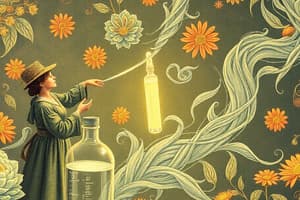Podcast
Questions and Answers
Who was the first scientific giant mentioned in the development of microbiology?
Who was the first scientific giant mentioned in the development of microbiology?
Louis Pasteur
Louis Pasteur believed that alcoholic fermentation was a strictly chemical process.
Louis Pasteur believed that alcoholic fermentation was a strictly chemical process.
False (B)
What concept did Pasteur challenge with his experiments?
What concept did Pasteur challenge with his experiments?
- Microbial resistance
- Spontaneous generation (correct)
- Germ theory
- Fermentation
Pasteur used _____ to eliminate contaminants.
Pasteur used _____ to eliminate contaminants.
What type of flask did Pasteur design to counter objections to his experiments?
What type of flask did Pasteur design to counter objections to his experiments?
Pasteur concluded that organisms found in putrefying materials originated from microorganisms in the ground.
Pasteur concluded that organisms found in putrefying materials originated from microorganisms in the ground.
What was the result when a nutrient solution was sealed in a glass flask and heated to boiling?
What was the result when a nutrient solution was sealed in a glass flask and heated to boiling?
The process of killing all bacteria is called _____...
The process of killing all bacteria is called _____...
Flashcards are hidden until you start studying
Study Notes
Pasteur and the Defeat of Spontaneous Generation
- French scientist Louis Pasteur (1822–1895) revolutionized microbiology in the mid-to late nineteenth century.
- Pasteur's research debunked the long-held theory of spontaneous generation.
- Pasteur's initial studies focused on alcoholic fermentation, challenging the belief that fermentation was purely a chemical process.
- Pasteur's research demonstrated that yeast cells, living organisms, were responsible for catalyzing fermentation.
- Pasteur's experiments with spontaneous generation revolved around studying the appearance of microorganisms in putrefying food.
- Pasteur's experiments demonstrated that microorganisms found in spoiling food were not generated spontaneously but originated from microorganisms present in the air and on surfaces.
- Pasteur showed that if food was sterilized, meaning all microorganisms were killed, and then protected from further contamination, it wouldn't putrefy.
- Pasteur used heat sterilization to eliminate contaminants from nutrient solutions and countered the claim that "fresh air" was necessary for spontaneous generation.
- Pasteur's swan-necked flask experiment elegantly disproved spontaneous generation.
- In this experiment, nutrient solutions were sterilized by boiling and left in flasks with bent necks. The bent necks allowed air to re-enter but trapped microorganisms from reaching the broth, preventing putrefaction.
- When the necks of the flasks were broken, exposing the broth directly to the air, the broth putrefied, confirming that microorganisms from the air were responsible for the contamination.
Studying That Suits You
Use AI to generate personalized quizzes and flashcards to suit your learning preferences.




